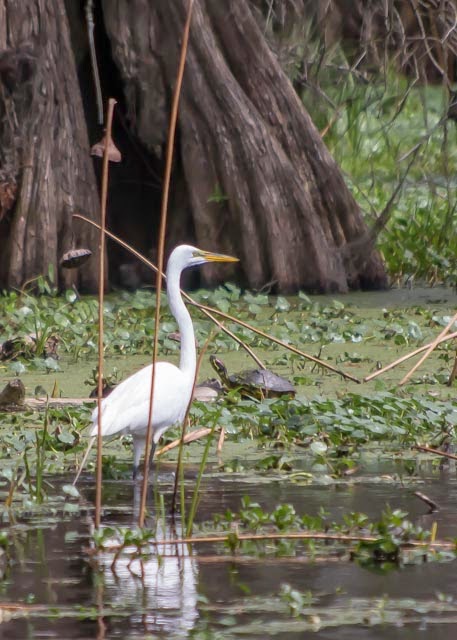Email: brqyvn@gmail.com
Hi Photographer friends,
#. 2 - Weekly Chronicle and Photo Album of our current two-year trip across the U.S. and Canada in a RV with our Ricoh/Pentax equipment.
This week, Breaux Bridge Louisiana and Cajun Country.
Breaux Bridge is a small
town of approximately 8,000 people. It is
located just off of Interstate 10 near Lafayette, in Southern Louisiana.
As we were travelling toward New Orleans,
on a rainy March Wednesday afternoon, we decided to stay overnight, somewhere
before New Orleans. We were scheduled to meet with my daughter on that Friday.
She was attending a conference there and we had arranged to meet while we were
travelling toward Florida.
(We had a great time in New Orleans and my
first Travelling post was indeed about New Orleans. You can read it here.)
We found a great RV park in Breaux
Bridge that day called Cajun Palms RV Resort. What we found there was great food, great amenities, and
most of all, great people. We had a great adventure in the swamp the next day, but first let
me tell you a little about Cajun Country.
------------------------------------------------------------
I am of Acadian descent, and Breaux Bridge is
known not only for being the crawfish capital of the world, but also for its
Acadian history. In the 17th century, a group of French families colonized land
in the area now known as Nova Scotia, in Canada. It was known as L'Acadie back
then. The “Acadiens” were modest people, who treasured their Divinity and
their kinfolk. They settled the good lands in the region, and developed a simple but prosperous culture. But the success was short-lived. Soon the British
arrived. In a ruthless act of racial cleansing, the British conquered the
Acadians, grabbed away their land, torched their homes, and divided their
families. Most of the Acadians were deported elsewhere. This period in Acadian
history is called "le grand derangement."
(The great inconvenience)
The Acadians were dispersed among American
colonies, England, and France. Eventually a few groups found their way to
Louisiana where they were welcomed by the Spanish government, who was ruling at
the time. Word quickly travelled that a "new Acadie" was being made,
and over the next few decades, many Acadian families came to Louisiana and were
united again with family. A new Acadie was born.\
We all know about how good Cajun cooking
is, but crawfish is probably the most famous food that originated from them. Mrs. Charles Hebert is credited with being the first
to put crawfish on a menu in the early 1920s, according to the Breaux Bridge
Historical Society. By the 1930s, crawfish were seen as a good source of
protein, especially for poor Cajuns, though it actually took some convincing to
get the locals to eat them. Crawfish etouffée
made its debut in the 1950s, and now is the typical Cajun dish.
Although my direct ancestors were not deported, and I was born in Canada, I have great admiration for my people for enduring such racism and coming out of it all triumphant.
------------------------------------------------------------
Now back to our stay at
Cajun Palms RV Resort. The next day, we awoke and decided to drive around and
explore the area. We first had breakfast at a very classic Southern Breakfast
restaurant, “The Waffle House."
Although not the best nourishment for arteries,
the food was delicious. From there, we drove toward the “Swamps” with the
intention of taking photos. We did
indeed take some okay images but saw a sign that said “Swamp tours." We stopped
and, lucky for us, the boat was about to leave and they allowed us to be part of
the last tour of the day. The following are images that I wouldn't have in my
gallery, had we have arrived five minutes later. Here goes…
 |
| This picture was obviously not taken by me. My wife took that shot with the Ricoh GR. |
 |
| Ricoh GR, 1/500 sec @ f/4.0, ISO 100 |
 |
| Pentax K-3, 1/500 sec @ f/4.0, ISO 100, smc Pentax 10-17 mm. |
 |
| Pentax K-3, 1/200 sec @ f/5.6, ISO 100, smc Pentax DA 50-200 mm @ 200 mm. Image was cropped. |
 |
| Pentax K-3, 1/60 sec @ f/18, ISO 640, smc Pentax DA 50-200 mm @ 160 mm. Image was cropped. |
 |
| Pentax K-3, 1//1000 sec @ f/5.6, ISO 640, smc Pentax DA 50-200 mm @ 150mm. Image was cropped |
 |
| Ricoh GR, 1/250 sec @ f/4.0, ISO 100, |
 |
| Pentax K-3, 1//100 sec @ f/14, ISO 200, smc Pentax DA 50-200 mm @ 200 mm. |
 |
| Pentax K-3, 1//60 sec @ f/14, ISO 200, smc Pentax DA 50-200 mm @ 105 mm. |
 |
| Ricoh GR, 1//250 sec @ f/4.0, ISO 100, |
Let's work with one image with Adobe Lightroom 5.0. The image below was taken in landscape because I was in a moving boat and had to hurry up. There wasn't any particular interest in it except that the egret had reflection and was surrounded by turtles. The lens used was the smc 50-200 mm and it isn't very sharp. I cropped the image, putting the bird in the 1/3 of the image. I added clarity, white, noise reduction and finally the maximum luminance I could. That made the image look more like a good water color painting. It is not a prize winning picture, but you can see how cropping and manipulation can improve an image.
 |
| Image after post process |
 |
| Original Image |






No comments:
Post a Comment